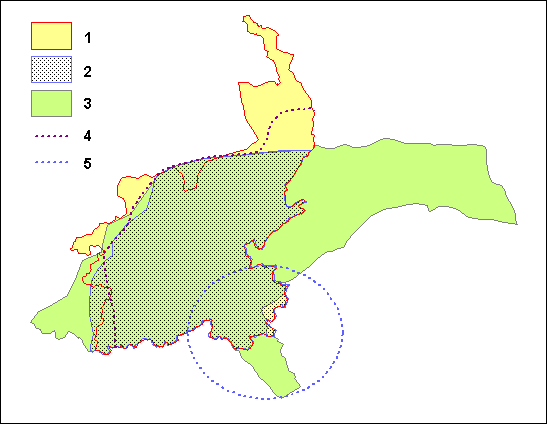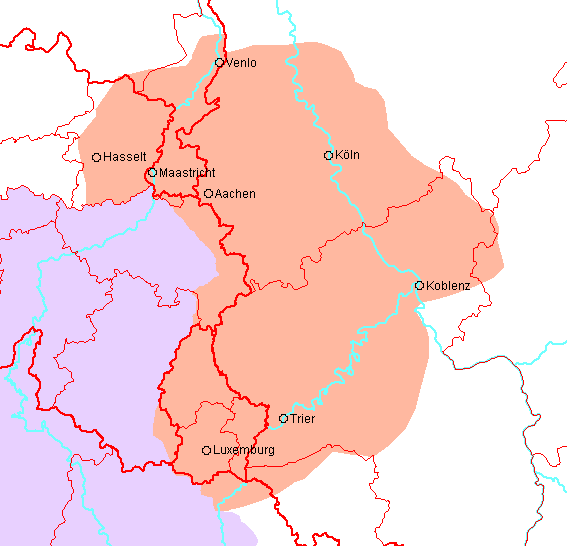|
Limburgish Language
Limburgish ( or ; ; also Limburgian, Limburgic or Limburgan) refers to a group of South Low Franconian varieties spoken in Belgium and the Netherlands, characterized by their distance to, and limited participation in the formation of, Standard Dutch. In the Dutch province of Limburg, all dialects, despite their differences, have been given collectively a regional language status, including those comprising "Limburgish" as used in this article. Limburgish shares many vocabulary and grammatical characteristics with both German and Dutch. A characteristic feature of many dialects of Limburgish is the occurrence of a lexical pitch accent ( Franconian tone accent), which is shared with the adjacent Central Franconian dialects of German. Etymology The name ''Limburgish'' (and variants of it) derives only indirectly from the now Belgian town of Limbourg (''Laeboer'' in Limburgish, IPA: /ˈlæːbuʁ/), which was the capital of the Duchy of Limburg during the Middle A ... [...More Info...] [...Related Items...] OR: [Wikipedia] [Google] [Baidu] |
Netherlands
, Terminology of the Low Countries, informally Holland, is a country in Northwestern Europe, with Caribbean Netherlands, overseas territories in the Caribbean. It is the largest of the four constituent countries of the Kingdom of the Netherlands. The Netherlands consists of Provinces of the Netherlands, twelve provinces; it borders Germany to the east and Belgium to the south, with a North Sea coastline to the north and west. It shares Maritime boundary, maritime borders with the United Kingdom, Germany, and Belgium. The official language is Dutch language, Dutch, with West Frisian language, West Frisian as a secondary official language in the province of Friesland. Dutch, English_language, English, and Papiamento are official in the Caribbean Netherlands, Caribbean territories. The people who are from the Netherlands is often referred to as Dutch people, Dutch Ethnicity, Ethnicity group, not to be confused by the language. ''Netherlands'' literally means "lower countries" i ... [...More Info...] [...Related Items...] OR: [Wikipedia] [Google] [Baidu] |
Duchy Of Limburg
The Duchy of Limburg or Limbourg was an imperial estate of the Holy Roman Empire. Much of the area of the duchy is today located within Liège Province of Belgium, with a small portion in the municipality of Voeren, an Enclave and exclave, exclave of the neighbouring Limburg (Belgium), Limburg Province. Its chief town was Limbourg, Limbourg-sur-Vesdre, in today's Liège Province. The duchy evolved from a county which was first assembled under the lordship of a junior member of the House of Ardenne–Luxembourg, Frederick, Duke of Lower Lorraine, Frederick. He and his successors built and apparently named the fortified town which the county, and later the duchy, were named after. Despite being a younger son, Frederick had a successful career and also became duke of Lower Lotharingia in 1046. Lordship of this county was not originally automatically linked with possession of a ducal title (''Herzog'' in German, ''Hertog'' in Dutch), and the same title was also eventually contested b ... [...More Info...] [...Related Items...] OR: [Wikipedia] [Google] [Baidu] |
Limbourg
Limbourg (; German and Dutch: ''Limburg''; ) or Limbourg-sur-Vesdre is a city and municipality of Wallonia located in the province of Liège, Belgium. On 1 January 2008, Limbourg had a total population of 5,680. The total area is 24.63 km2 which gives a population density of 231 inhabitants per km2. The municipality consists of the following districts: Bilstain, Goé, and Limbourg. The lower part of the town, along the Vesdre, is called Dolhain. Etymology and history The second part of the name Limbourg is from ''burg'' meaning a fortified town, which is common in many parts of Europe where Germanic languages are spoken or have been spoken historically (see Germanic placename etymology). Concerning the first part of the name, there are various theories. One is ''lint'' meaning "dragon". Another is that it refers back to the Roman-era limes, situated at boundaries of the Empire. It may also have been related to the material ''lim'' or lime. Jean-Louis Kupper has ... [...More Info...] [...Related Items...] OR: [Wikipedia] [Google] [Baidu] |
Central Franconian
Central or Middle Franconian () refers to the following continuum of West Central German dialects: * Ripuarian (spoken in the German state of North Rhine-Westphalia, in eastern Belgium, and the southeastern tip of Dutch Limburg) * Moselle Franconian (in German Rhineland-Palatinate and Saarland, in eastern Belgium and French Lorraine) ** Luxembourgish (in Luxembourg and the adjacent areas of Belgium and France) Luxembourgish is often included within Moselle Franconian, but sometimes regarded as a separate group. The German-speaking Community of Belgium comprises both Ripuarian and Moselle Franconian dialects. The Central Franconian dialects are part of a continuum stretching from the Low Franconian language area in the northwest to the Rhine Franconian dialects in the southeast. Along with Limburgish, Central Franconian has a simple tone system called pitch accent. The Central Franconian language area is not to be confused with the Bavarian administrative district of Middle ... [...More Info...] [...Related Items...] OR: [Wikipedia] [Google] [Baidu] |
Franconian Tone Accent
A pitch-accent language is a type of language that, when spoken, has certain syllables in words or morphemes that are prominent, as indicated by a distinct contrasting pitch (music), pitch (tone (linguistics), linguistic tone) rather than by volume or length, as in some other languages like English language, English. Pitch-accent languages also contrast with fully tonal languages like Vietnamese language, Vietnamese, Thai language, Thai and Standard Chinese, in which practically every syllable can have an independent tone. Some scholars have claimed that the term "pitch accent" is not coherently defined and that pitch-accent languages are just a sub-category of tonal languages in general. Languages that have been described as pitch-accent languages include: most dialects of Serbo-Croatian, Slovene language, Slovene, Baltic languages, Ancient Greek, Vedic Sanskrit, Tlingit language, Tlingit, Turkish language, Turkish, Japanese language, Japanese, Limburgish, Norwegian language, No ... [...More Info...] [...Related Items...] OR: [Wikipedia] [Google] [Baidu] |
Pitch Accent (intonation)
Pitch accent is a term used in autosegmental- metrical theory for local intonational features that are associated with particular syllables. Within this framework, pitch accents are distinguished from both the abstract metrical stress and the acoustic stress of a syllable. Different languages specify different relationships between pitch accent and stress placement. Typology Languages vary in terms of whether pitch accents must be associated with syllables that are perceived as prominent or stressed. For example, in French and Indonesian, pitch accents may be associated with syllables that are not acoustically stressed, but in English and Swedish, syllables that receive pitch accents are also stressed. Languages also vary in terms of whether pitch accents are assigned lexically or post-lexically. Lexical pitch accents are associated with particular syllables within words in the lexicon and can serve to distinguish between segmentally similar words. Post-lexical pitch accents a ... [...More Info...] [...Related Items...] OR: [Wikipedia] [Google] [Baidu] |
Lexical Rule
A lexical rule is in a form of syntactic rule used within many theories of natural language syntax. These rules alter the argument structures of lexical items (for example verbs and declensions) in order to alter their combinatory properties. Lexical rules affect in particular specific word classes and morphemes. Moreover, they may have exceptions, do not apply across word boundaries and can only apply to underlying form In some models of phonology as well as morphophonology in the field of linguistics, the underlying representation (UR) or underlying form (UF) of a word or morpheme is the abstract form that a word or morpheme is postulated to have before any phon ...s. An example of a lexical rule in spoken English is the deletion of /n/. This rule applies in ''damn'' and ''autumn'', but not in ''hymnal''. Because the rule of n-deletion apparently needs information about the grammatical status of the word, it can only be lexical. Lexical rules are the inverse of postlexical ru ... [...More Info...] [...Related Items...] OR: [Wikipedia] [Google] [Baidu] |
Dutch Language
Dutch ( ) is a West Germanic languages, West Germanic language of the Indo-European language family, spoken by about 25 million people as a first language and 5 million as a second language and is the List of languages by total number of speakers, third most spoken Germanic language. In Europe, Dutch is the native language of most of the population of the Netherlands and Flanders (which includes 60% of the population of Belgium). "1% of the EU population claims to speak Dutch well enough in order to have a conversation." (page 153). Dutch was one of the official languages of South Africa until 1925, when it was replaced by Afrikaans, a separate but partially Mutual intelligibility, mutually intelligible daughter language of Dutch. Afrikaans, depending on the definition used, may be considered a sister language, spoken, to some degree, by at least 16 million people, mainly in South Africa and Namibia, and evolving from Cape Dutch dialects. In South America, Dutch is the native l ... [...More Info...] [...Related Items...] OR: [Wikipedia] [Google] [Baidu] |
German Language
German (, ) is a West Germanic language in the Indo-European language family, mainly spoken in Western Europe, Western and Central Europe. It is the majority and Official language, official (or co-official) language in Germany, Austria, Switzerland, and Liechtenstein. It is also an official language of Luxembourg, German-speaking Community of Belgium, Belgium and the Italian autonomous province of South Tyrol, as well as a recognized national language in Namibia. There are also notable German-speaking communities in other parts of Europe, including: Poland (Upper Silesia), the Czech Republic (North Bohemia), Denmark (South Jutland County, North Schleswig), Slovakia (Krahule), Germans of Romania, Romania, Hungary (Sopron), and France (European Collectivity of Alsace, Alsace). Overseas, sizeable communities of German-speakers are found in the Americas. German is one of the global language system, major languages of the world, with nearly 80 million native speakers and over 130 mi ... [...More Info...] [...Related Items...] OR: [Wikipedia] [Google] [Baidu] |
Regional Language
* A regional language is a language spoken in a region of a sovereign state, whether it be a small area, a federated state or province or some wider area. Internationally, for the purposes of the European Charter for Regional or Minority Languages, "''regional or minority languages''" ''means languages that are:'' #''traditionally used within a given territory of a State by nationals of that State who form a group numerically smaller than the rest of the State's population and'' #''different from the official language(s) of that State'' Recognition of regional or minority languages must not be confused with recognition as an official language. Relationship with official languages In some cases, a regional language may be closely related to the state's main language or official language. For example: *The Frisian languages spoken in the Netherlands and Germany, which belong to the Germanic family. *The Gutnish language, a regional language spoken in Gotland and related to ... [...More Info...] [...Related Items...] OR: [Wikipedia] [Google] [Baidu] |
Standard Dutch
Dutch ( ) is a West Germanic language of the Indo-European language family, spoken by about 25 million people as a first language and 5 million as a second language and is the third most spoken Germanic language. In Europe, Dutch is the native language of most of the population of the Netherlands and Flanders (which includes 60% of the population of Belgium). "1% of the EU population claims to speak Dutch well enough in order to have a conversation." (page 153). Dutch was one of the official languages of South Africa until 1925, when it was replaced by Afrikaans, a separate but partially mutually intelligible daughter language of Dutch. Afrikaans, depending on the definition used, may be considered a sister language, spoken, to some degree, by at least 16 million people, mainly in South Africa and Namibia, and evolving from Cape Dutch dialects. In South America, Dutch is the native language of the majority of the population of Suriname, and spoken as a second or third lan ... [...More Info...] [...Related Items...] OR: [Wikipedia] [Google] [Baidu] |


